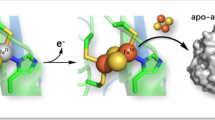Abstract
Electron transfer occurs through heme-Fe across the cytochrome c protein. The current models of long range electron transfer pathways in proteins include covalent σ-bonds, van der Waals forces, and through space jump. Hydrogen-bond-linked pathways of delocalized electron units in peptide units and polar side chains of amino acid residues in proteins and internal water molecules are better suited for intramolecular atom-to-atom electron transfer in proteins. Crystal structures of cytochrome c proteins from horse (1HRC), tuna (3CYT), rice (1CCR), and yeast (3CX5) were analyzed using pymol software for ‘Hydrogen Bonds’ marking the polar atoms within the distance of 2.6–3.3 Å and tracing the atom-to-atom pathways linked by hydrogen bonds. Pathways of hydrogen-bond-linked peptide units, polar side chains of the amino acid residues, and buried water molecules connect heme-Fe through axially coordinated Met80-S and His18-N have been traced in cytochrome c proteins obtained from horse, tuna, rice and yeast with an identical hydrogen-bonded sequence around the heme-Fe: Asn-N–water-O–Tyr-O–Met-S–heme-Fe–His (HN–C=N)–Pro-Asn-Pro-Gly (peptide unit, HN–C=O)—water-O. More than half of the amino acid residues in these pathways are among the conserved list and delocalized electron units, internal water molecules and hydrogen bonds are conspicuous by their presence.




Similar content being viewed by others
References
Banci L, Bertini I, Rosato A, Varani G (1999) Mitochondrial cytochromes c: a comparative analysis. J Biol Inorg Chem 4:824–837
Margoliash E, Shelagh F-M, Tulloss J, Kang CH, Feinberg DL, Brautigan DL, Morrson M (1973) Separate intramolecular pathways for reduction and oxidation of cytochrome c in electron transport chain reactions (monoiodotyrosine 74 cytochrome c/4-nitrobenzo-2-oxa-1,3-diazole lysine 13 cytochrome c/bis-phenylglyoxal arginine 13 cytochrome c). Proc Nat Acad Sci USA 70:3245–3249
Moore GR, Williams RJP (1976) The electron-transfer proteins. Coord Chem Rev 18:125–135
Eley DD, Spivey DI (1960) The semiconductivity of organic substances. Trans Faraday Soc 56:1432–1442
Gray HB (1990) Long-range electron transfer in proteins. Aldrichimica Acta 23:86–93
Beretan DN, Onuchic JN, Betts JN, Bowler BE, Gray HB (1990) Electron tunneling pathways in ruthenated proteins. J Am Chem Soc 112:7915–7921
Therein MJ, Selemen M. Gray HB, Chang I-Jy, Winkler JR (1990) Long-range electron transfer in ruthenium-mediated cytochrome c: evaluation of porphyrin-ruthenium electronic coupling in Candida krusei and horse heart proteins. J Am Chem Soc 112:2420–2422
Wuttke DS, Bjerrum MJ, Winkler JR, Gray HB (1992) Electron-tunneling pathways in cytochrome c. Science 256:1007–1009
Arrhenius TS, Blanchard-Desce M, Dvolaitzky M, Lehn J-M (1986) Molecular devices: carioviologens as an approach to molecular wires-synthesis and incorporation into vesicle membranes. Proc Natl Acad Sci USA 83:5355–5359
Davydov AS (1973) The theory of contraction of proteins under their excitation. J Theor Biol 38:559–569
Ramasarma T, Vijayan M (1974) Suprahelical arrangements of hydrogen bonds in peptide helices. FEBS Lett 41:307–309
Chandra AK, Sudhindra BS, Vijayan M, Ramasarma T (1978) A theory on the migration of an extraneous electron across hydrogen bonds in polypeptides. J Theor Biol 74:1–9
De Rege PJF, Williams SA, Therien MJ (1995) Direct evaluation of electronic coupling mediated by hydrogen bonds: implications for biological electron transfer. Science 269:1409–1413
Nishino T, Hayashi N, Bui PT (2013) Direct measurement of electron transfer through a hydrogen bond between single molecules. J Am Chem Soc 135:4592–4595
Deepak RNVK, Sivaramakrishnan R (1967) Unconventional N–H⋯N hydrogen bonds involving proline backbone nitrogen in protein structures. Biophys J 110:1967–1979
Mundlapati VR, Ghosh S, Bhattacherjee A, Tiwari P, Biswal HS (2015) Critical assessment of the strength of hydrogen bonds between the sulfur atom of methionine/cysteine and backbone amides in proteins. J Phys Chem Lett 6:1385–1389
Bushnell GW, Louie GV, Brayer GD (1990) High-resolution three-dimensional structure of horse heart cytochrome c. J Mol Biol 214:585–595
Smith HT, Ahmed AJ, Millet F (1981) Electrostatic interaction of cytochrome c with cytochrome c 1 and cytochrome oxidase. J Biol Chem 256:4984–4990
Takano T, Dickerson RE (1981) Conformation change of cytochrome c: II. Ferricytochrome c refinement at 1·8 Å and comparison with the ferrocytochrome structure. J Mol Biol 153:95–115
Luntz TL, Schejter A, Garber EA, Margoliash E Luntz TL, Schejter A, Garber EA, Margoliash E (1989) Structural significance of an internal water molecule studied by site-directed mutagenesis of tyrosine-67 in rat cytochrome c. Proc Natl Acad Sci USA 86:3524–3528
Berghuis AM, Guillemette JG, McLendon G, Sherman F, Smith M, Brayer GD (1994) Role of a conserved internal water molecule and its associated hydrogen bond network in cytochrome c. J Mol Biol 286, 786–799
Ramasarma T (2000) In praise of the hydrogen bond. In Lal M, Lillford PJ, Naik VM, Prakash V (eds) Supramolecular and colloidal structures in biomaterials. Imperial College Press and the Royal Society, London, pp 450–462
Acknowledgements
We are grateful to Prof. P. Balaram for his support in carrying out this work. We thank Prof. E. Arunan for helpful discussions on hydrogen bond and van der Waals forces. TR is an emeritus scientist of the Indian National Science Academy, New Delhi, India.
Author information
Authors and Affiliations
Corresponding author
Ethics declarations
Conflict of interest
T. Ramasarma and D. Vaigundan declare that none of them have any conflict of interest.
Rights and permissions
About this article
Cite this article
Ramasarma, T., Vaigundan, D. Hydrogen bond-linked pathways of peptide units and polar groups of amino acid residues suitable for electron transfer in cytochrome c proteins. Mol Cell Biochem 453, 197–203 (2019). https://doi.org/10.1007/s11010-018-3445-2
Received:
Accepted:
Published:
Issue Date:
DOI: https://doi.org/10.1007/s11010-018-3445-2




